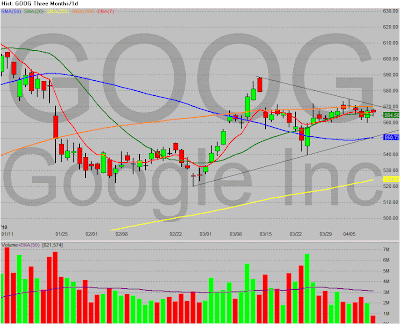Here are the charts we posted real-time on the GMCR trade. It wasn't a big win but it's a decent strategy we use for buying support and it was fun discussing it real-time (and was satisfying seeing traders make some money in it).
Most traders are aware of buying dips on trending stocks in the
stock market on the 20EMA/5 minute chart. We do that all the time and it works very well. One less common strategy is to look for stocks that have bottomed, make higher lows, flatten under the EMA, and then buy through the EMA with stop under the higher low. Let's take a closer look at the charts
we posted today.
The first chart is one we noticed on GMCR weakness on the daily chart. Stock was hugging the trend-line again and we were looking to see whether it would get downward pressure.

Stock broke through the trend-line but bounced right on top of a mini-support right under it. In a market as strong as this one our main focus has been long, be it break-outs or support longs, so we were interested.

Here's a closer look of the support right under the trend-line. Typical head-fake under trend-line shaking out weak holders.

Stock made higher low which was good -- next step was to base under the EMA and stop it from trending down. Flatten the EMA and through was what we were looking for.

We got the start of the move through the EMA and as we posted real-time, we started buying.

After that the point is to adjust the stop, always just below the EMA or if you want to make sure not to get head-faked, then a closing candle under the EMA.


As we posted when GMCR was at 96, we took off all the day-trade size but left on a small swing trade with stop above entry over 95.2. This is a "house money" trade that we'll keep on with little risk in case stock wants higher in the next few days.
Again, not a big trade, but a close, real-time, look at how to use the 20EMA to help buy support.












